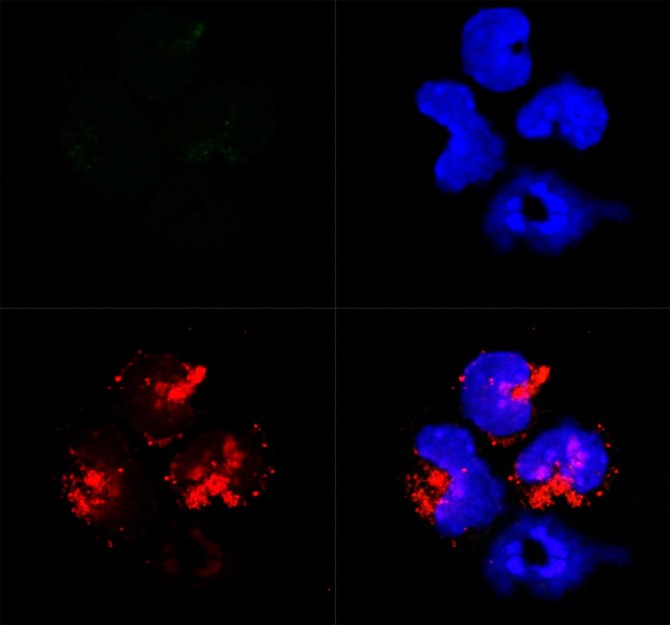Stress-fighting proteins could lead to asthma treatments
By Janelle Weaver
Weill Cornell Medical College investigators have discovered the precise molecular steps that enable immune cells implicated in certain forms of asthma and allergy to develop and survive in the body. The findings reveal a new pathway that scientists could use to develop more effective treatments and therapies for the chronic lung disorder.
More than 1 in 12 Americans are affected by asthma, a disorder characterized by an overactive immune response to normally harmless substances such as pollen or mold. Scientists previously had found that an overabundance of immune cells called eosinophils, which help defend the body against parasites and infection, are implicated in certain forms of asthma as well as in allergic reactions. But little was known about how eosinophils develop and survive.
In their study, published July 6 in Nature Immunology, the researchers discovered that a signaling pathway, formed by two proteins that help cells survive stressful conditions, also plays a critical role in eosinophil development. When the researchers altered the function of either of those proteins, the eosinophils, but not other cell types, underwent excess stress and were completely wiped out. This suggests that the pathway could serve as a new therapeutic target for patients who respond poorly to current asthma therapies.
“Our findings demonstrate that individual cell types, particularly eosinophils, interpret and manage stress in distinct ways,” said lead author Dr. Sarah E. Bettigole, a postdoctoral fellow at Weill Cornell. “If we disrupt the ability to respond to stress, sensitive cells like eosinophils die off. These subtle differences could be leveraged to develop novel therapies for diseases like asthma and eosinophilic leukemia.”
Eosinophils belong to a group of cells called granulocytes, which develop in the bone marrow before migrating into blood. During early stages of development, these cells produce proteins that are critical for survival, as well as toxic proteins that are later released in response to an immune trigger, such as bacteria or viruses. Intense bursts of protein production during normal biological processes put strain on a cell structure called the endoplasmic reticulum (ER), which plays a crucial role in protein synthesis and transport. If the ER is overwhelmed by such strain, the cell enters a state known as ER stress.
In response to ER stress, a protein called IRE1alpha helps to generate a highly active form of a second protein called XBP1, which in turn regulates the activity of various genes involved in the cell stress response. This signaling pathway reduces ER stress and prevents cell death by enhancing the ER's protein synthesis capacity while reducing overall protein production.
“Because XBP1 supports the survival of certain mature cell types that make a lot of protein throughout their lives, we suspected that XBP1 might also help cells like eosinophils cope with intense bursts of protein production during development,” said senior author Dr. Laurie H. Glimcher, the Stephen and Suzanne Weiss Dean of Weill Cornell Medical College.
In support of this idea, the research team found that the IRE1alpha/XBP1 pathway became increasingly active in differentiating eosinophils as they produced more and more proteins during progressive developmental stages. Moreover, genetically modified mice that were deficient in XBP1 completely lacked eosinophils in the bone marrow, spleen and blood, while other granulocytes were unaffected.
“So far, XBP1 is the only transcription factor to our knowledge that distinguishes the development of eosinophils from that of other granulocytes,” Glimcher said. “This suggests that subtle differences in cellular biological processes provide a previously unappreciated handle for fine-tuning the production of different types of granulocytes.”
The loss of XBP1 in eosinophils also altered the activity of genes that are critical for the ER stress response, leading to the accumulation of incorrectly processed proteins, substantial ER swelling and severe granule dysfunction. Without XBP1, the researchers discovered that developing eosinophils underwent too much stress. This stalled their differentiation by blocking a molecule called GATA1, which ensures that young eosinophils finish maturing into adult eosinophils. The researchers found that too much stress and not enough GATA1 eventually killed the eosinophils.
Taken together, the findings suggest that ER health is crucial for eosinophil development and survival, highlighting the IRE1alpha/XBP1 pathway as a potential therapeutic target in a wide variety of eosinophil-mediated diseases.
The researchers are testing whether experimental XBP1 or IRE1alpha inhibitors can be effective treatments for asthma and eosinophil leukemia.
“We now know that XBP1 is required for normal eosinophil development, but we need to figure out whether eosinophil-mediated respiratory illnesses and cancers are also dependent on this pathway,” Bettigole said. “If these diseases are eosinophil-dependent, blocking IRE1alpha or XBP1 with pharmaceuticals would be an exciting new treatment strategy.”
Janelle Weaver is a freelance writer for Weill Cornell's Office of External Affairs.
Media Contact
Get Cornell news delivered right to your inbox.
Subscribe